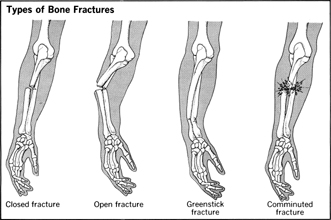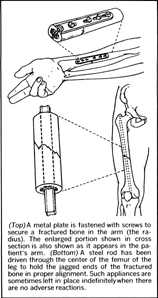Injury to Bones and Joints: Fractures and Dislocations
B ones can be broken or displaced when the body is subjected to a violent impact or when a limb is suddenly wrenched out of its normal position. Auto and bicycle accidents and accidents in and around the home account for many such injuries. See Ch. 31, Medical Emergencies , for information on accidents and how to provide treatment.
A fracture is a break in a bone as a result of injury or pathological weakness. Tumors, for example, can destroy bones to such an extent that a spontaneous fracture occurs due to pathological weakness. Osteoporosis can also cause such fractures.
A dislocation is a displacement of any part, especially a bone. During this process the joint-capsule ligaments and muscle may be torn. The displaced bones must be reset by a bone specialist in their original position and immobilized until healing is complete. If this is not done, there is every possibility that the unhealed muscles will not provide the necessary support, thereby causing chronic spontaneous dislocation.

Injury ( trauma ) to bones and joints should not be dismissed lightly, especially if pain persists. If untreated, fractures and dislocations may heal with the bones out of alignment. Permanent deformity and joint degeneration are two possible complications.
Crush injuries, such as those occurring in some industrial and automobile accidents, may result in the clogging or blockage of blood vessels that supply blood to an extremity. When this happens, tissues below the blockage may die, and wounds do not heal because of lack of oxygenated blood and nutrition. If the fractures and wounds are not properly treated, gangrene , or the death of soft tissues, can sometimes result, requiring amputation just above the site of blockage and at a location that will make the healing process possible.
Kinds of Fractures
Incomplete fractures are those that do not destroy the continuity of the bone. In a complete fracture , the bone is completely broken across. A simple or closed fracture is one in which the fragments are held together under the surface of the skin by the muscles and soft tissues. In a compound or open fracture one or both fragments pierce the skin, resulting in an open wound. In some cases the bony fragments can be seen protruding through the skin.
Comminuted fractures are the result of crushed bones. Several fragments appear at the trauma site. Greenstick fractures occur when one side of the bone is broken and the other bent. This type of fracture is more common in long bones, especially the forearms, clavicle, and legs of young children. Stress fractures , tiny cracks in the bone, can occur in the bones of the foot or leg of athletes who put these bones under repeated stress, such as ballet dancers and long-distance runners.
Healing of Fractures
When a bone breaks, new bone cells called callus are laid down at the ends of the fracture to unite the fragments. This is the beginning of the healing process, the speed of which is dependent on the nature of the fracture.
Simple, incomplete, and greenstick fractures heal readily. Rest is usually sufficient to heal stress fractures. However, compound fractures have wounds and fragments to complicate the healing process. Cleaning and suturing the wound and administering antibiotics reduce the chance of infection and promote healing.
Comminuted fractures may have to be disimpacted and all fragments reset, usually by an orthopedic or general surgeon. Some very serious fractures of the extremities may require surgical insertion of metallic pins, nails, plates, wires, or screws to hold the fragments in proper position, thereby promoting rapid healing with minimal deformity. Such devices must be made from corrosion-free and rustproof metals because they may remain in the body for a few months or throughout the person's lifetime.
Age and the Healing Process
The age of the fracture victim determines the speed of healing. In healthy, normal children, broken bones mend quickly because a rapid bone-cell manufacturing process is constantly in progress during the growth of the child. This is further advanced by proper diet, including daily intake of milk and milk products to provide the calcium required to build healthy bones.
In young adults, new bone cells do not develop as rapidly as in the growing child, but under normal circumstances, this will not present problems with the healing of fractures. Fractures in the aged heal slowly or not at all, depending on the age and health of the individual.
Treatment of Fractures
Correction of a fracture or dislocation is called reduction and is usually performed by an orthopedic surgeon. Bones that are merely cracked do not require reduction; they heal with the aid of immobilization. More serious fractures require manipulation, pressure, and sometimes, as mentioned above, wires, pins, nails, and screws, to bring the fragments together so that they can unite.
Healing of fractures and dislocations following reduction requires proper immobilization, which also reduces pain by preventing movement of the fragments. Immobilization is usually accomplished by the use of splints or plaster casts or by applying traction . Traction subjects the fractured member to a pulling force by means of a special apparatus, such as a system of weights and pulleys.

After a fracture or dislocation is reduced and immobilized in a cast, the injury is X-rayed to ensure that the immobilized reduction will heal without deformity. If the reduction is not satisfactory, the cast is removed, the fragments are remanipulated to provide better reduction, and a new cast or bandage is applied. Periodic X-ray rechecks help the physician ascertain the degree of new bone formation as the healing continues. Casts are also checked to make sure there is not excess swelling of tissues and compression of blood vessels in the area.
How long a cast must remain depends on the extent of the injury and the rapidity of healing. A broken wrist may heal in four to six weeks while a fractured tibia may require four months of immobilization in a plaster cast.
Pubic Fracture
Pubic fractures can cause ruptures of the bladder with urine leaking into the pelvic cavity. Routine urinalysis for the presence of blood cells is always necessary in cases of pelvic fractures. Surgical repair of the bladder may be required.

Comment about this article, ask questions, or add new information about this topic: